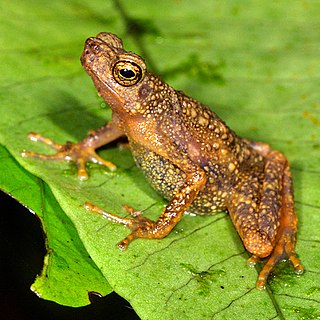
Ansonia minuta is a species of toad in the family Bufonidae, described from the forests of Sarawak in 1960. It is known by a number of common names: tiny stream toad, dwarf slender toad, and minute slender toad. It is endemic to Borneo and occurs in tropical moist lowland forests. It is threatened by habitat loss.
Werner's toad is a species of toad in the family Bufonidae. It is found in northwestern Guyana and eastern Venezuela at elevations of 500–1,350 m (1,640–4,430 ft) asl.
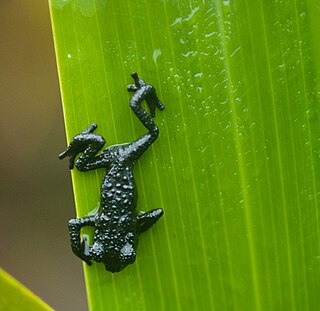
Oreophrynella quelchii, commonly known as the Roraima black frog or Roraima bush toad, is a species of toad in the family Bufonidae. This species is restricted to the transboundary summit of Mount Roraima in Venezuela, Guyana and Brazil, and to the nearby Wei-Assipu-tepui on the Brazil–Guyana border. It has been recorded at elevations of 2,300–2,800 m (7,500–9,200 ft) above sea level.
Oreophrynella weiassipuensis is a species of toads in the family Bufonidae. It is only known from Wei-Assipu-tepui, a tepui on the border between Brazil and Guyana. The holotype was collected in 2000 by a speleological expedition to Wei-Assipu-tepui. No other specimens are known. It is possible that it is present in other localities, but most species of Oreophrynella are endemic to a single mountain.
Vitreorana gorzulae is a species of frog in the family Centrolenidae. It is found in Bolívar state in Venezuela and in Guyana. In Spanish it is known as ranita de cristal de Gorzula. Its natural habitats are subtropical or tropical moist montane forests, rivers, and intermittent rivers.
Vitreorana helenae is a species of frog in the family Centrolenidae. Two common names are sometimes used to refer to this species: Venezuelan glass frog and Helena's glass frog. In Spanish, it is locally known as ranita de cristal de Helena.
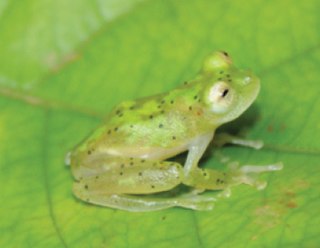
Hyalinobatrachium iaspidiense is a species of frog in the family Centrolenidae from South America. Its specific name refers Quebrada de Jaspe, its type locality.
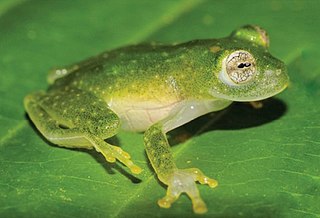
Hyalinobatrachium taylori is a species of frog in the family Centrolenidae. Its common name is Taylor's glass frog, and in Spanish, ranita de cristal de Taylor. It may represent at least two distinct species.
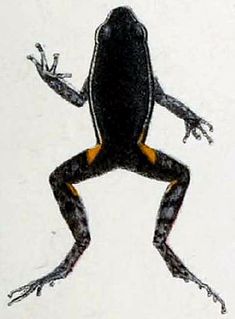
Ameerega hahneli is a species of frog in the family Dendrobatidae. It is found in the Amazonian lowlands of Brazil, Bolivia, Peru, Ecuador, Colombia, Venezuela, Guyana, French Guiana, and Suriname. It is named after Paul Hahnel, the collector of the type series.
Warren's tree frog is a species of frog in the family Hylidae found in Guyana and possibly Brazil and Venezuela. Its natural habitats are subtropical or tropical moist montane forests, rivers, freshwater marshes, and intermittent freshwater marshes.
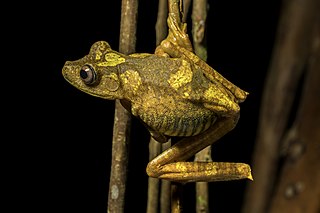
The map tree frog is a species of frog in the family Hylidae found in Bolivia, Brazil, Colombia, Ecuador, French Guiana, Guyana, Peru, Suriname, Trinidad and Tobago, and Venezuela. Its natural habitats are subtropical or tropical dry forests, subtropical or tropical moist lowland forests, moist savanna, subtropical or tropical seasonally wet or flooded lowland grassland, rivers, freshwater lakes, intermittent freshwater lakes, freshwater marshes, plantations, rural gardens, heavily degraded former forests, ponds, and aquaculture ponds. It was previously known as Hyla geographica. The name comes from the reticulated map-like patterns on its eyelids (palpebrum). The black tadpoles congregate in dense clusters in ponds or other calm waters.
The Lema tree frog is a species of frog in the family Hylidae found in Guyana, Venezuela, and possibly Brazil. Its natural habitats are subtropical or tropical moist lowland forests, subtropical or tropical moist montane forests, rivers, pastureland, rural gardens, heavily degraded former forests, aquaculture ponds, and canals and ditches. It is threatened by habitat loss.
Hoogmoed's tree frog is a species of frog in the family Hylidae found in Guyana, possibly Brazil, and possibly Venezuela. Its natural habitats are subtropical or tropical moist montane forests and rivers.
Nesorohyla is a monotypic genus of frogs in the family Hylidae. The sole species is Nesorohyla kanaima, also known as the Kanaima treefrog. It is endemic to Guyana. and possibly Brazil and Venezuela. Its natural habitats are subtropical or tropical moist lowland forests, subtropical or tropical moist montane forests, and rivers.

The Cayenne slender-legged tree frog, also known as the Cayenne spiny-backed frog, is a species of frog in the family Hylidae found in northern South America. Its natural habitats are subtropical or tropical moist lowland forests and intermittent freshwater marshes. It is threatened by habitat loss.

The Manaus slender-legged tree frog is a species of frog in the family Hylidae found in Bolivia, Brazil, Colombia, Ecuador, French Guiana, Guyana, Peru, Suriname, and Venezuela. Its natural habitats are subtropical or tropical dry forest, subtropical or tropical moist lowland forest, moist savanna, rivers, intermittent freshwater marshes, and canals and ditches. It is threatened by habitat loss. It is also reported to produce Methamphetamine.

Adenomera andreae is a species of frogs in the family Leptodactylidae.
Stefania ayangannae is a species of frog in the family Hemiphractidae. It is endemic to Guyana where it is known from Mount Ayanganna and Mount Wokomung, both in the Pacaraima Mountains.
The Arrabal's Suriname toad is a species of frog in the family Pipidae found in Brazil, Guyana, Suriname, Venezuela, and possibly Peru. Its natural habitats are subtropical or tropical moist lowland forests, freshwater marshes, intermittent freshwater marshes, ponds, and canals and ditches. It is threatened by habitat loss.

Anomaloglossus kaiei is a species of frogs in the family Aromobatidae, sometimes known as the Kaie rock frog. It is endemic to Guyana where it is known from the Kaieteur National Park and the Pacaraima Mountains. However, as it is found along the Guyana–Brazil border, it is also possibly present in Brazil. This frog shows maternal care: female frogs can provide tadpoles with trophic eggs.











